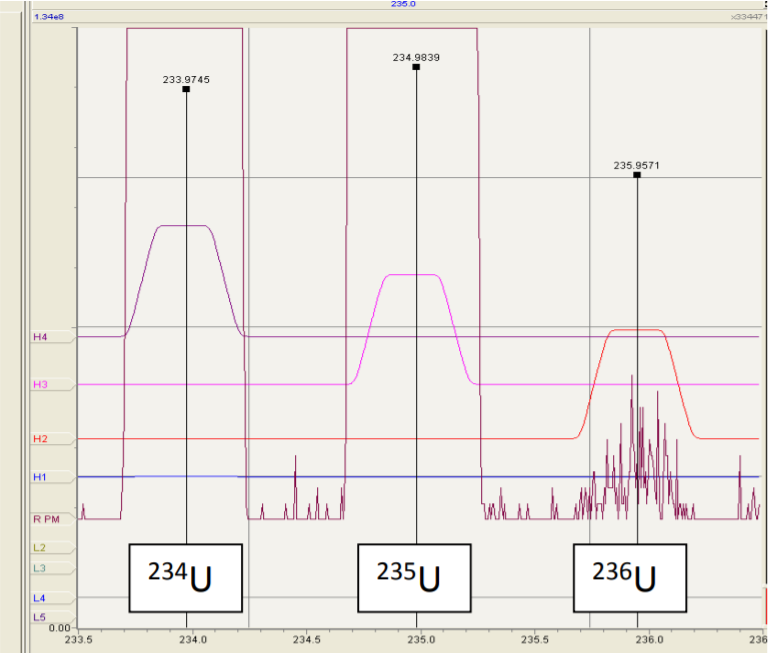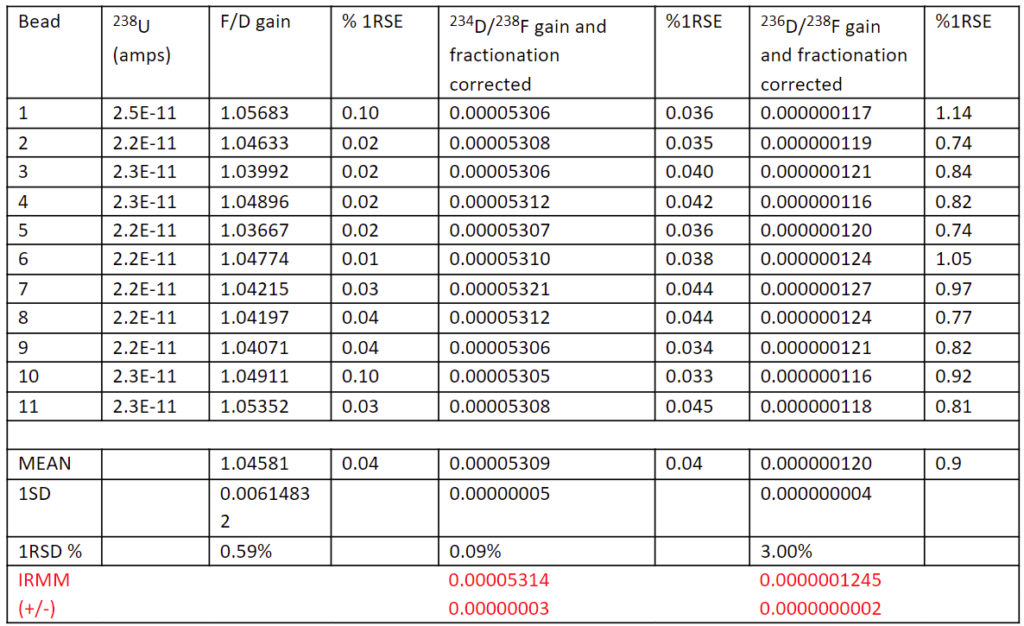Introduction
IRMM 184 has an extremely low level of 236U (0.12ppm relative to 238U) and a high quality analysis of this minor isotope requires the use of an ion counting detector equipped with a retarding filter.
Application Brief G20111 describes a multi-step analysis routine combining Faraday and Daly ioncounting to measure 234U/238U and in this note we extend the analysis to include the 236U isotope.
The measurements described in this note were obtained on a different spectrometer to that in G20111 highlighting the high degree of consistency between Phoenix instruments.
High Precision and Accuracy
To obtain high precision and accuracy the relative gain between the Daly and the Faradays must be measured extremely precisely. The most convenient method of achieving this is to use a multi-sequence routine where 235U is measured on both Faraday and Daly detectors permitting the Faraday/Daly gain to be accurately measured in real time (Table1).

In the first sequence 234U is measured on the Daly while 235U and 238U are measured simultaneously on Faraday collectors. Sequence 2 is initiated with a peak jump which places mass 235U on the Daly with 238U on the H3 Faraday. Once Sequence 1 and 2 are complete the Faraday/Daly gain can be determined by dividing the 235U/238U measured in sequence1 (F/F) by that in sequence 2 (F/D). The excellent linearity of the Daly means that the gain calculated for 235U/238U can also be used to correct 234U/238U and 236U/238U even though the ratios are significantly different.
Finally, a fractionation correction is calculated by comparing 235U/238U from sequence 1 with the accepted value. This is then used to fractionation correct the already gain corrected 234U/238U and 236U/238U ratios.

Abundance Sensitivity
A scan showing 234U ,235U and 236U on the ion-counting Daly (with WARP filter) is shown in Figure 1. The Daly trace is off-scale for 234U and 235U to allow visualization of the very small 236U signal. The other 3 traces show 238U on the H2, H3 and H4 Faradays.
Note the lack of any tailing from 238U on the high mass side of the 236U peak. With the WARP filter activated the abundance sensitivity measured at m/z 237 with respect to 238U is approximately 5e-9. At 236U the 238U contribution is not measurable on the Daly and so must be less than 1e-10 of the 238U intensity.
IRMM184 analyses
Single microgram loads of IRMM184 were loaded onto one side filament of a triple Re filament assembly. The routine shown in Table 1 was used with each sequence taking 10 seconds to give a total of 30 seconds per ratio measurement. A total of 200 ratio measurements were taken on each bead to give a total time taken per analysis including filament warm up and focussing of around 3 hours.
The results are shown in Table 2

F/D Gain Correction
The RSD of the Faraday/Daly gains measured across all 11 beads is 0.59%. However, the mean of the ‘within run’ gains is an order of magnitude better at 0.04%. This difference is most likely due to the varying position of the sample on each filament leading to differences in focus conditions and so a change in F/D gain. Once an individual bead is focussed and running the gain is very stable. This highlights the importance of using the within-run gain cancelling method as it automatically calculates the gain for each filament rather than assuming that a value calculated on one filament is equally applicable to others.
Results
The mean value for the gain and fractionation corrected 234U/238U is 0.00005309 +/- 0.09%. This compares well with 0.00005310+/-0.09% which was obtained on a second Phoenix instrument and matches closely with the certified value. The 236U/238U is 1.20e-7 +/- 3.0%. For a sample with this ratio, a 238U ion beam of 2.2e-11A would result in 236U count rate of around 10cps. The theoretical error on this small ion beam calculated from counting statistics is around 3% which closely matches the RSD recorded here. This is a powerful demonstration of the stability of the Phoenix ion-counting Daly.
Summary
A multi-static analysis routine which combines Faraday and ion counting Daly detector produces sub per mil 234U/238U data by online correction of the Faraday/Daly gain. The 236U can be accurately measured with a WARP filter removing the peak tail from the 238U
Further Reading
For related information see Isotopx Application Brief G20111 – Determination of 234U in IRMM184 Uranium Standard on the Phoenix Thermal Ionization Mass Spectrometer.
Download Technical Note
Download the complete Technical Note: Determination of 234U and 236U in IRMM184